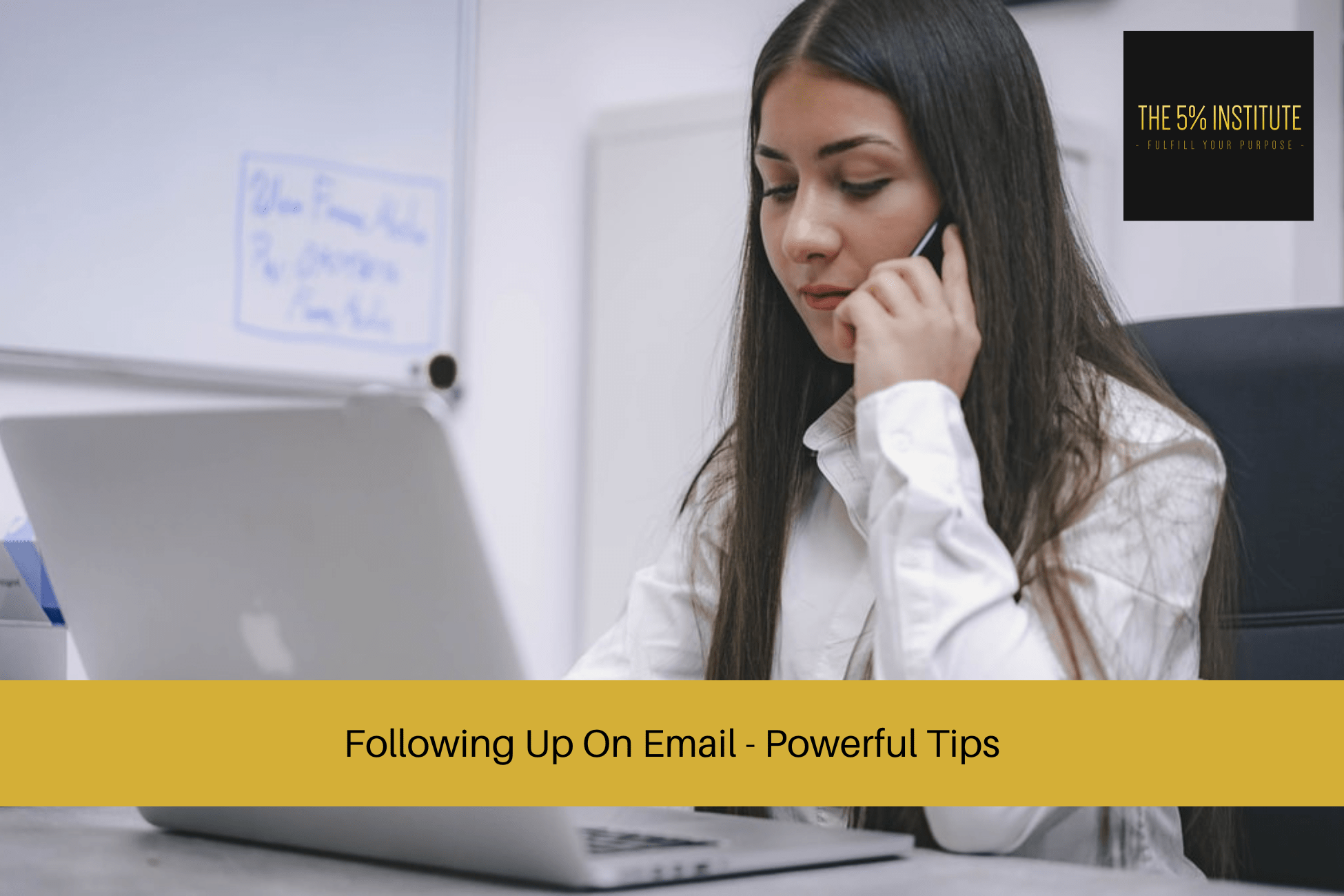
Following Up On Email – Powerful Tips
Following up on email is a great opportunity if done correctly.
In today’s fast-paced digital world, email has become an indispensable tool for communication.
Whether it’s for personal or professional purposes, email allows us to connect with others quickly and efficiently.
However, sending an email doesn’t guarantee a response.
Sometimes, messages get lost in the sea of inboxes, or recipients simply overlook them.
That’s where the art of following up on email comes into play.
In this article, we will explore the importance of following up, share some strategies for effective follow-ups, and provide you with valuable tips to increase your chances of getting a response.
Introduction
In this digital age, email has become the primary mode of communication for both personal and professional interactions.
While it is convenient and efficient, the sheer volume of emails that individuals receive daily makes it challenging to stand out and get a timely response.
Following up on email is an essential practice that can significantly increase the likelihood of getting the attention you deserve.
Why Following Up Matters
Following up on an email demonstrates your commitment, professionalism, and genuine interest in the recipient’s response.
It shows that you value their time and are proactive in ensuring effective communication.
Moreover, a well-timed and well-crafted follow-up can be the difference between a missed opportunity and a successful outcome.
Timing is Everything
Timing plays a crucial role in the effectiveness of a follow-up email.
You don’t want to be too hasty and come across as pushy, nor do you want to wait too long and risk missing out on the recipient’s attention.
A general rule of thumb is to follow up within one to two business days after sending the initial email.
This timeframe strikes a balance between being responsive and giving the recipient enough time to review their inbox.
Crafting an Effective Follow-Up Email
When crafting a follow-up email, it’s essential to keep it concise, clear, and personalized.
Start by referencing the original email and reminding the recipient of its purpose.
Be specific about what you are following up on, and clearly state your desired outcome.
Additionally, consider adding value or new information that may incentivize the recipient to respond.
Personalization and Persistence
Personalization is key to making your follow-up email stand out.
Address the recipient by their name, mention specific details from your previous conversation, and tailor your message to their interests or needs.
This personal touch shows that you genuinely care about establishing a connection.
Additionally, persistence is crucial when following up.
If you don’t receive a response to your initial follow-up, consider sending a polite reminder after a reasonable interval.
Politeness Goes a Long Way
Politeness is a fundamental aspect of effective communication.
Always maintain a polite and professional tone in your follow-up emails.
Avoid sounding demanding or entitled, as it may deter the recipient from responding.
Remember to express gratitude for their time and consideration, regardless of whether they respond or not.
The Power of Subject Lines
Subject lines are the gateways to your emails.
They need to be attention-grabbing, concise, and relevant.
When following up on an email, ensure that your subject line clearly indicates that it is a follow-up message.
Consider using phrases like “Just a Friendly Reminder” or “Following Up on Our Conversation” to increase the chances of your email being opened and read.
Leveraging Technology for Efficient Follow-Ups
Technology can be a valuable ally in streamlining your email follow-up process.
Email automation tools allow you to schedule and send follow-up emails automatically, ensuring that you never miss an opportunity.
Additionally, email tracking tools provide valuable insights into open rates and click-through rates, enabling you to assess the effectiveness of your follow-up strategies.
Tools and Resources to Enhance Email Follow-Up
Several tools and resources are available to enhance your email follow-up efforts.
CRM (Customer Relationship Management) software can help you keep track of conversations, set reminders for follow-ups, and organize your contacts efficiently.
Email templates and snippets can also save you time and effort by providing pre-written messages that can be customized for each recipient.
Following Up on Unresponsive Emails
Dealing with unresponsive emails can be frustrating, but it’s essential not to give up too soon.
If you haven’t received a response after your initial follow-up, consider sending a second follow-up with a polite request for confirmation or an alternative way to get in touch.
Persistence, combined with a respectful approach, can sometimes yield positive results.
Following Up on Important Business Matters
When it comes to critical business matters, following up is even more crucial.
Whether it’s a proposal, contract negotiation, or deadline confirmation, a well-timed and well-crafted follow-up email can ensure that your message receives the attention it deserves.
Be proactive, professional, and persistent in your approach, and always keep the recipient’s priorities and deadlines in mind.
Following Up with Potential Clients or Customers
Following up with potential clients or customers is an integral part of building relationships and closing deals.
After an initial meeting, send a follow-up email expressing your gratitude for their time and reiterating the key points discussed.
Stay in touch with periodic follow-ups to nurture the relationship and provide relevant information that aligns with their needs or interests.
Tracking and Analysing Follow-Up Emails
Tracking and analysing the effectiveness of your follow-up emails is essential for continuous improvement.
Use email tracking tools to monitor open rates, click-through rates, and response rates.
Analyse the data to identify patterns, refine your approach, and tailor your follow-up strategies based on what works best for your audience.
Following Up On Email – Conclusion
Following up on email is a powerful way to enhance communication, build relationships, and increase your chances of receiving a response.
By implementing the strategies and tips shared in this article, you can become a master of the art of following up.
Remember to be timely, personalized, polite, and persistent.
Keep refining your approach, learn from each interaction, and watch your email communication thrive.
FAQs
1. How many times should I follow up on an email?
The number of follow-ups depends on the urgency and importance of the matter.
It is generally acceptable to send two or three follow-ups, allowing sufficient time between each email.
2. Is it appropriate to follow up on weekends or holidays?
It’s best to avoid sending follow-up emails during weekends or holidays, as people may be away from work or busy with personal commitments.
Try for weekdays within regular business hours for better response rates.
3. Should I include the original email in my follow-up message?
Yes, it’s a good practice to include the original email thread or reference key points from the previous conversation.
This helps jog the recipient’s memory and provides context for your follow-up.
4. How long should I wait before sending a follow-up email?
Waiting one to two business days is generally considered appropriate before sending a follow-up email.
This timeframe allows the recipient to review their inbox and respond at their convenience.
5. What should I do if I still don’t receive a response after multiple follow-ups?
If you’ve sent multiple follow-ups and haven’t received a response, it may be appropriate to explore alternative methods of communication, such as a phone call or a personal visit.
Use your judgment based on the nature of the matter and the relationship with the recipient.
Want To Close Sales Easier?
Are you committed to closing sales a lot easier, and consistently?
If so, you should check out our self-paced and affordable online sales training program; The 5% Sales Blueprint.
It’ll give you everything you need to close sales consistently.
To learn more, simply click on the link below for more information.
Our Online Sales Training Program – The 5% Sales Blueprint.



